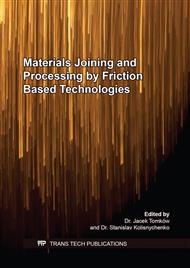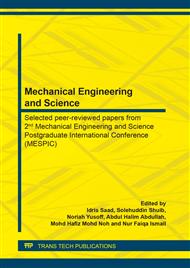[1]
T. Türk and O. Fabrikası, Friction stir spot welding for automotive applications,, vol. 1, no. 3, p.114–118, (2017).
Google Scholar
[2]
K. J. K. M. Y. S. K. Y. H. S. et. Al., Influence of tool plunge depth and welding distance on friction stir lap welding of AA5454-O aluminum alloy plates with different thicknesses,, ransactions Nonferrous Met. Soc. China, vol. 19, no. SUPPL. 1, pp. s23–s27, (2012).
DOI: 10.1016/s1003-6326(12)61775-0
Google Scholar
[3]
Y. D. A. G. Zhikang Shen, Advances in friction stir spot welding,, J. Crit. Rev. Solid State Mater. Sci., (2019).
Google Scholar
[4]
S. R. Sekhar, V. Chittaranjandas, D. Govardhan, and R. Karthikeyan, Effect Of Tool Rotational Speed On Friction Stir Spot Welded Aa5052 – H38 Aluminum Alloy,, Mater. Today Proc., vol. 5, no. 2, p.5536–5543, (2018).
DOI: 10.1016/j.matpr.2017.12.144
Google Scholar
[5]
T. Fu, W.-Y. Li, X.-W. Yang, J.-F. Li, and D.-L. Gao, State-of-the-art of friction stir spot welding,, Cailiao Gongcheng/Journal Mater. Eng., vol. 43, no. 4, (2015).
Google Scholar
[6]
Z. Zhang, X. Yang, J. Zhang, G. Zhou, X. Xu, and B. Zou, Effect of welding parameters on microstructure and mechanical properties of friction stir spot welded 5052 aluminum alloy,, Mater. Des., vol. 32, no. 8–9, p.4461–4470, (2011).
DOI: 10.1016/j.matdes.2011.03.058
Google Scholar
[7]
Z. Shen, X. Yang, Z. Zhang, L. Cui, and T. Li, Microstructure and failure mechanisms of refill friction stir spot welded 7075-T6 aluminum alloy joints,, Mater. Des., vol. 44, p.476–486, (2013).
DOI: 10.1016/j.matdes.2012.08.026
Google Scholar
[8]
R. Muhayat, Triyono, Effect of Tool Plunge Depth and Pin Profile on Mechanical Properties of Friction Stir Spot Welded AA5052 Joints,, in ICAME, (2017).
DOI: 10.4028/www.scientific.net/amm.493.709
Google Scholar
[9]
M. Awang, Simulation of Friction Stir Spot Welding ( FSSW ) Process : Study of Friction Phenomena,, (2007).
Google Scholar
[10]
J. M. Piccini and H. G. Svoboda, Effect of pin length on Friction Stir Spot Welding (FSSW) of dissimilar Aluminum-steel joints,, Procedia Mater. Sci., vol. 9, p.504–513, (2015).
DOI: 10.1016/j.mspro.2015.05.023
Google Scholar
[11]
M. Imam, K. Biswas, and V. Racherla, Effect of weld morphology on mechanical response and failure of friction stir welds in a naturally aged aluminium alloy,, Mater. Des., vol. 44, p.23–34, (2013).
DOI: 10.1016/j.matdes.2012.07.046
Google Scholar
[12]
M. Haghshenas and A. P. Gerlich, Joining of automotive sheet materials by friction-based welding methods: A review,, Eng. Sci. Technol. an Int. J., vol. 21, no. 1, p.130–148, (2018).
DOI: 10.1016/j.jestch.2018.02.008
Google Scholar
[13]
Y. Bozkurt and M. K. Bilici, Application of Taguchi approach to optimize of FSSW parameters on joint properties of dissimilar AA2024-T3 and AA5754-H22 aluminum alloys,, Mater. Des., vol. 51, p.513–521, (2013).
DOI: 10.1016/j.matdes.2013.04.074
Google Scholar
[14]
Y. J. Kwon, S. B. Shim, and D. H. Park, Friction stir welding of 5052 aluminum alloy plates,, Trans. Nonferrous Met. Soc. China (English Ed., vol. 19, no. SUPPL. 1, pp. s23–s27, (2009).
DOI: 10.1016/s1003-6326(10)60239-7
Google Scholar
[15]
Armansyah Armansyah. Ho Hwi Chie, Optimization Of Process Parameters On Tensile Shear Load Of Friction Stir Spot Welded Aluminum Alloy AA5052-H112),, J. Sinergi, vol. 22, no. 3, p.185–192, (2018).
DOI: 10.22441/sinergi.2018.3.007
Google Scholar
[16]
F. V. Gianluca Buffa, Pierluigi Fanelli Livan Fratinia, Influence of joint geometry on micro and macro mechanical properties of friction stir spot welded joints,, Procedia Eng., vol. 81, no. 2, p.2086–2091, (2014).
DOI: 10.1016/j.proeng.2014.10.290
Google Scholar
[17]
V. V. Patel et al., Effect of Tool Rotation Speed on Friction Stir Spot Welded AA5052-H32 and AA6082-T6 Dissimilar Aluminum Alloys,, Metallogr. Microstruct. Anal., vol. 5, no. 2, p.142–148, (2016).
DOI: 10.1007/s13632-016-0264-2
Google Scholar
[18]
A. Hobbacher, IIW document IIW-1823-07 FATIGUE DESIGN OF WELDED. (2008).
Google Scholar
[19]
C. R. A. Schneider and S. J. Maddox, Best Practice Guide on Statistical Analysis of Fatigue Data. International Institute of Welding, XIII-WG1-114-03, no. February. (2003).
Google Scholar
[20]
P. J. Ross, Taguchi Techniques for Quality Engineering, no. New York: McGraw-Hill. (1996).
Google Scholar
[21]
P. S. Effertz, V. Infante, L. Quintino, U. Suhuddin, S. Hanke, and J. F. Santos, Fatigue life assessment of friction spot welded 7050-T76 aluminium alloy using Weibull distribution,, Int. J. Fatigue, (2016).
DOI: 10.1016/j.ijfatigue.2016.02.030
Google Scholar
[22]
P. Lin, J. Pan, and T. Pan, Failure modes and fatigue life estimations of spot friction welds in lap-shear specimens of aluminum 6111-T4 sheets . Part 2 : Welds made by a flat tool,, Int. J. Fatigue, vol. 30, p.90–105, (2008).
DOI: 10.1016/j.ijfatigue.2007.02.017
Google Scholar
[23]
S. V. K. S Venukumar, Yalagi S G, Muthukumaran S, Static shear strength and fatigue life of refill friction stir spot welded AA 6061-T6 sheets,, Sci. Technol. Weld. Join., vol. 19, no. 3, p.214–223, (2014).
DOI: 10.1179/1362171813y.0000000181
Google Scholar
[24]
D. S. A.M.S. Malafaia, M.T. Milan, M.F. Oliveira, Fatigue behavior of friction stir spot welding and riveted joints in an Al alloy,, in Procedia Engineering, 2010, p.1815–1821.
DOI: 10.1016/j.proeng.2010.03.195
Google Scholar
[25]
P. Lin, J. Pan, and T. Pan, Failure modes and fatigue life estimations of spot friction welds in lap-shear specimens of aluminum 6111-T4 sheets . Part 1 : Welds made by a concave tool,, Int. J. Fatigue, vol. 30, p.74–89, (2008).
DOI: 10.1016/j.ijfatigue.2007.02.016
Google Scholar



